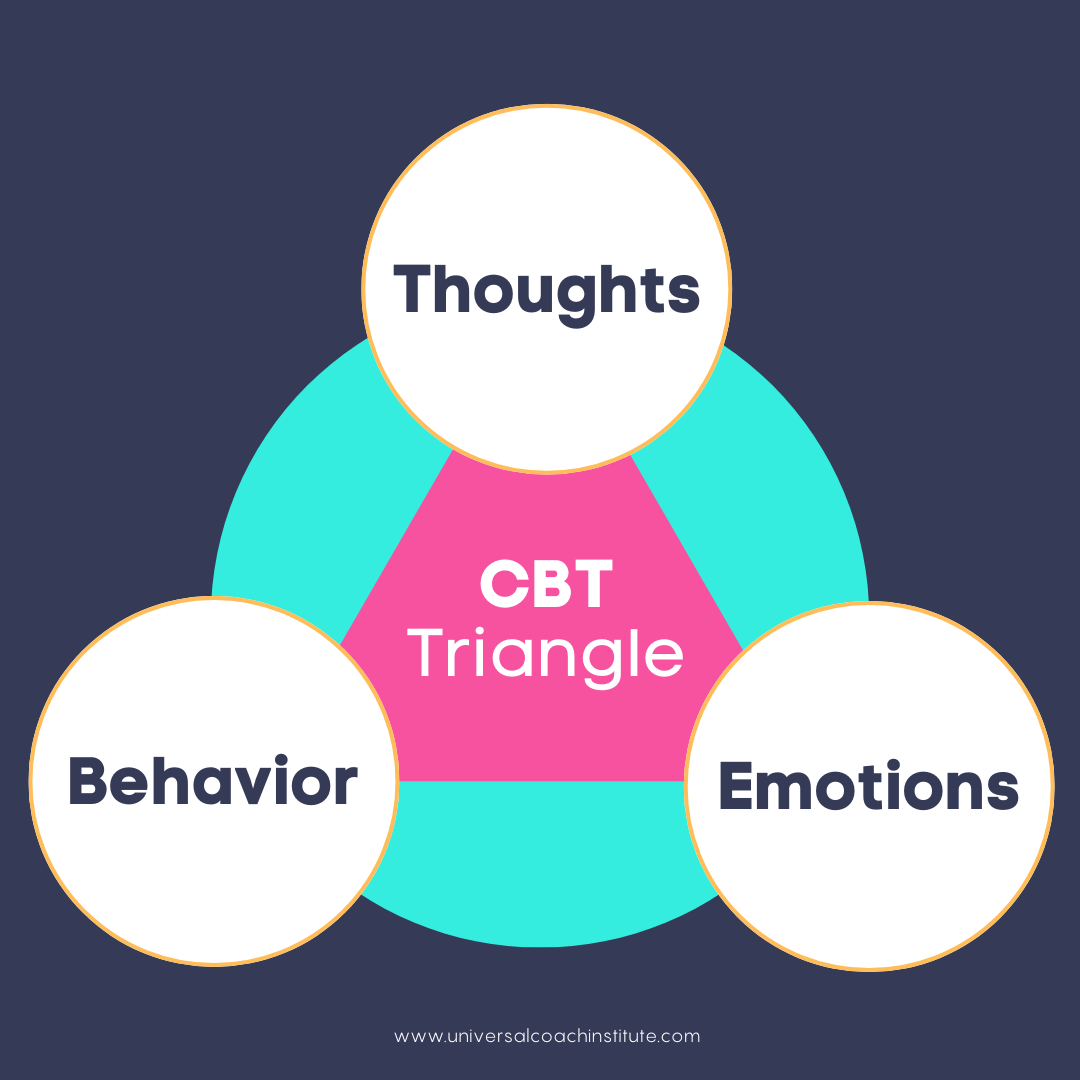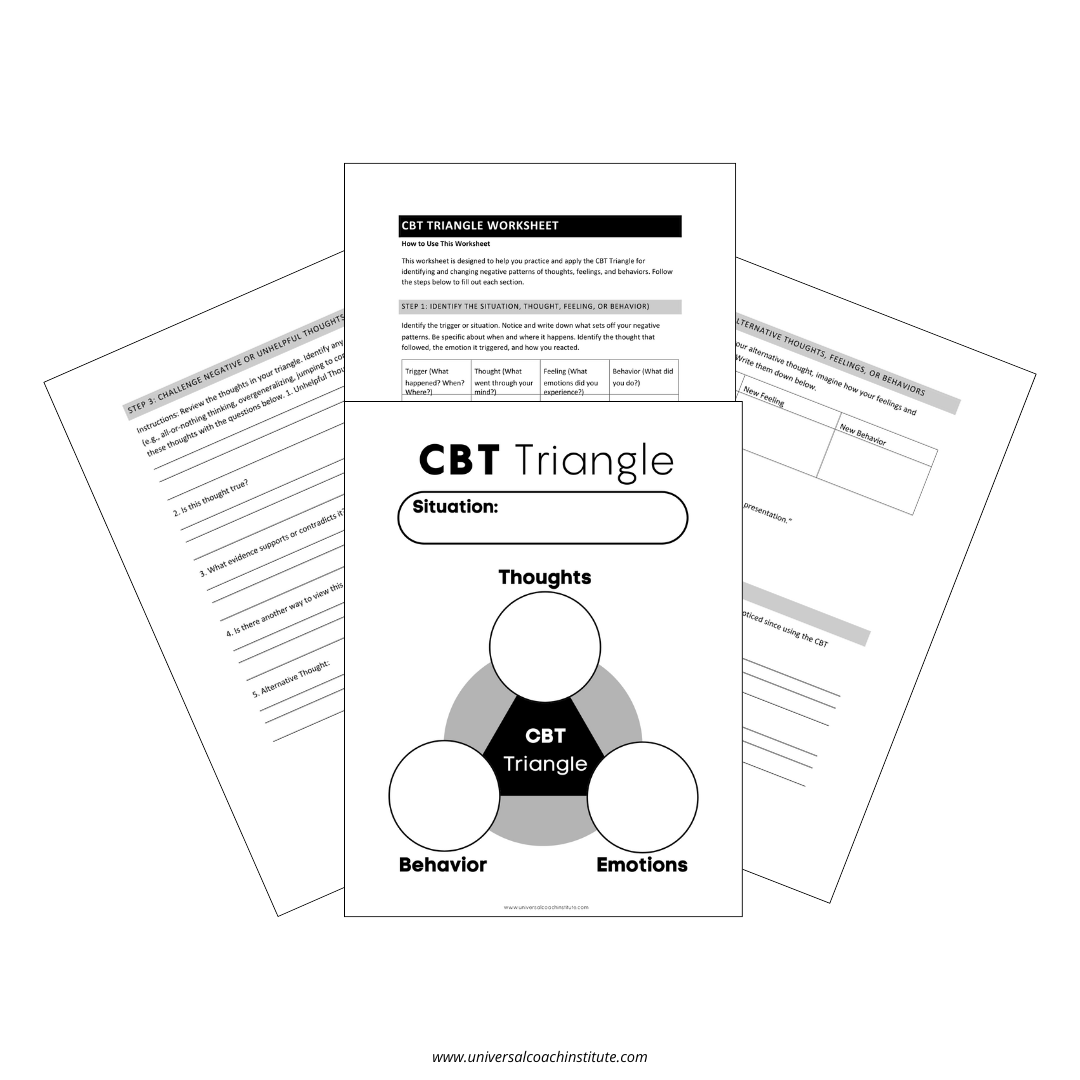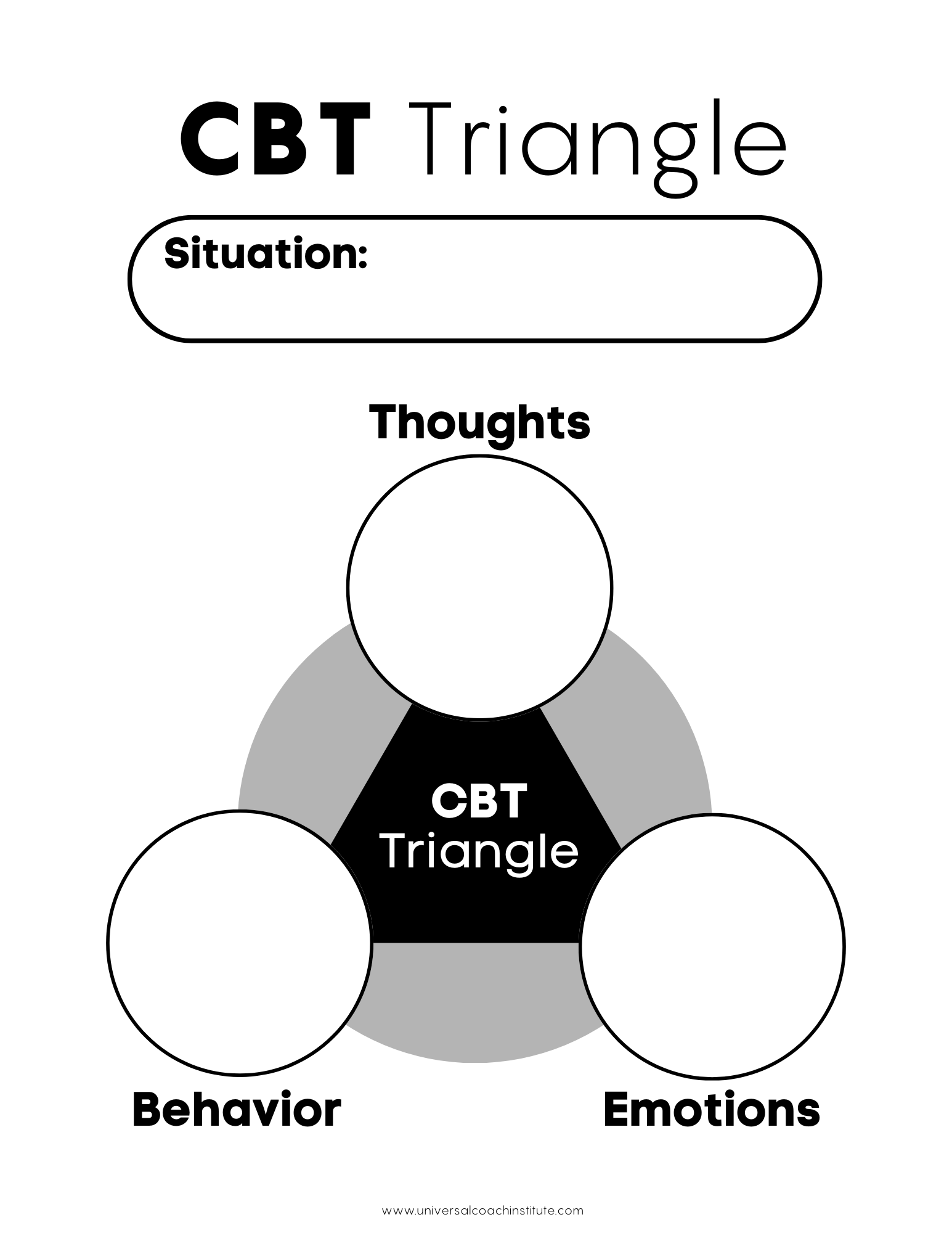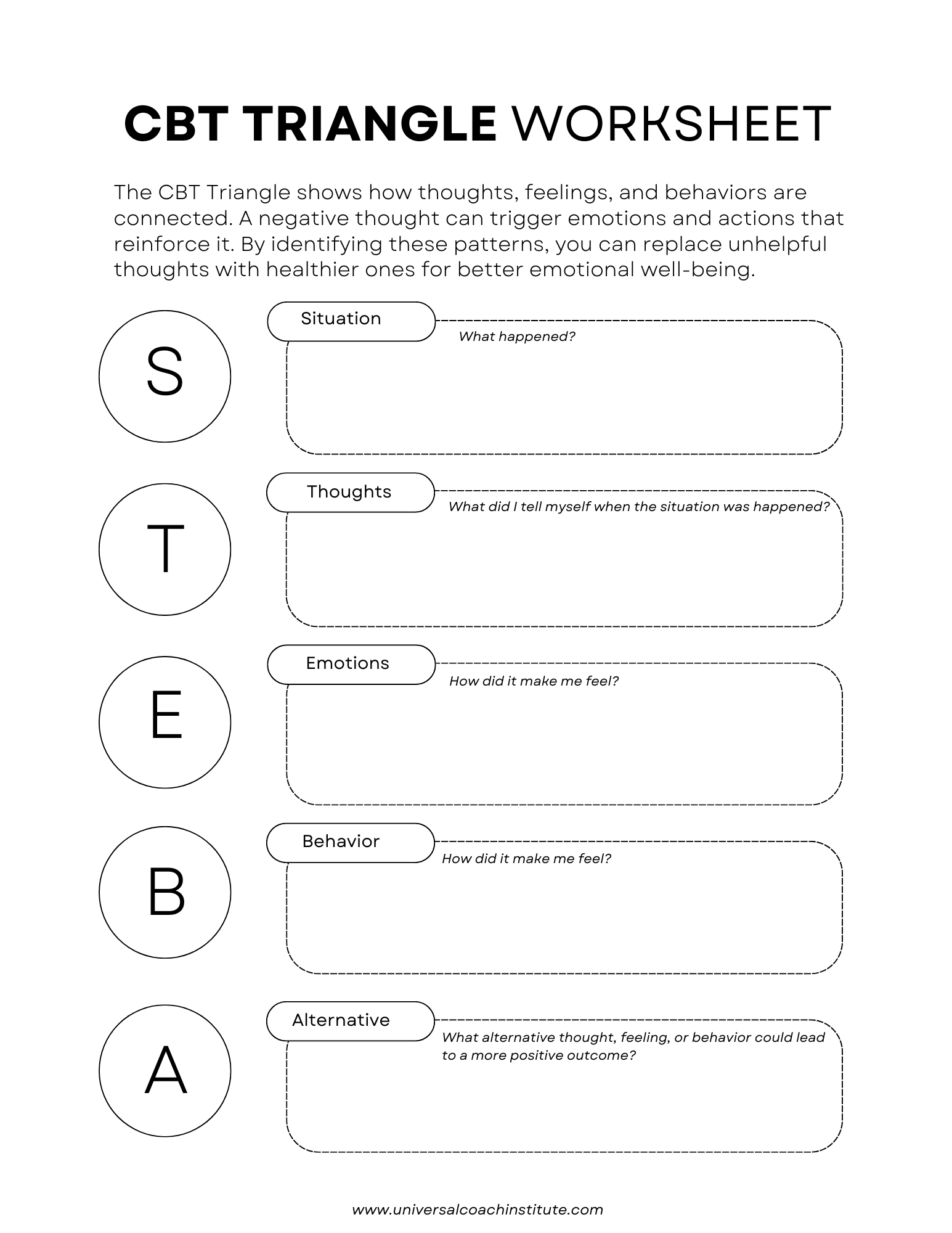The CBT Triangle is a visual framework that illustrates the interconnectedness of thoughts, feelings, and behaviors. It is the cornerstone of Cognitive Behavioral Therapy (CBT). CBT is a form of psychotherapy that helps people change negative thoughts and behaviors. It was developed in the 1960s by Psychiatrist Aaron T. Beck.
This blog post will explain how the CBT triangle and a CBT triangle worksheet can help mental health and emotional strength.
What is the CBT Triangle?
The CBT triangle is a visual representation that shows how thoughts, feelings, and behaviors are connected. Each component affects the others, creating patterns that can either perpetuate negativity or foster positive change. By exploring these connections, individuals gain insights into their mental and emotional processes.

What are the components of the CBT Triangle?
The CBT triangle has three main elements:
- Thoughts: These are the beliefs, assumptions, and interpretations we hold about ourselves, others, and the world. For example, thinking, “I’m not good enough,” can influence other parts of the triangle.
- Feelings: Emotions such as sadness, anxiety, anger, or joy that arise in response to our thoughts.
- Behaviors: The actions or reactions we exhibit, such as avoiding situations, engaging socially, or seeking support.
Each part of the triangle affects the others.
Psychiatrist Aaron T. Beck wrote a book called “Cognitive Therapy and the Emotional Disorders.” In this book, he suggested that negative thoughts can lead to emotional distress and maladaptive behaviors. By identifying and modifying these negative thoughts, individuals can experience improvements in their emotional well-being and behavior.
For instance, a negative thought like “I’ll fail at this task” might generate anxiety (feeling) and result in procrastination (behavior), reinforcing the thought of failure.
Why is the CBT Triangle central to Cognitive Behavioral Therapy?
The CBT triangle is a fundamental tool in cognitive-behavioral therapy.
Practitioners use it to:
- Help clients identify patterns that contribute to mental health challenges.
- Teach strategies for interrupting negative cycles.
- Encourage the adoption of healthier thoughts and behaviors.
Clients often use the triangle to track their progress and develop greater self-awareness. This approach provides a roadmap for addressing issues such as anxiety, depression, and stress.
A study in the Journal of Consulting and Clinical Psychology written by Dimidjian et al. (2006) found that CBT using this model helped 60% of people with depression. The triangle gives a clear map for working on mental health issues.
How Does the CBT Triangle Work?
The CBT triangle shows how thoughts, feelings, and behaviors connect and influence each other. This tool helps people spot unhelpful patterns and make positive changes.
How Thoughts, Feelings, And Behaviors Interact
The CBT triangle demonstrates the bidirectional relationships between its components:
- Thoughts influence feelings and behaviors: Negative self-talk can lead to discouraging emotions and avoidance behaviors.
- Feelings shape thoughts and actions: Experiencing sadness can trigger self-critical thoughts and withdrawal from social interactions.
- Behaviors impact emotions and beliefs: Engaging in physical activity or seeking help can improve mood and challenge negative assumptions.
For instance, thinking, “I’m no good at sports,” might cause feelings of sadness. This could lead to skipping team tryouts. And not trying out then supports the belief of being bad at sports.
This cycle works in positive ways, too. For example, thinking, “I can overcome challenges,” fosters confidence and proactive behaviors. This reinforces the belief in one’s abilities.
What are some examples of the CBT Triangle in daily life?
The CBT triangle plays out in many everyday situations.
For example:
- A student who thinks “I’m bad at math” may feel anxious and avoid studying. This leads to poor test results, reinforcing the negative belief.
- Meanwhile, a person with social anxiety might think, “People will judge me” at a party. They feel nervous, and as a result, they stand alone in a corner. Others see them as unfriendly, confirming their fears.
Positive examples include:
- An athlete who thinks “I’ve trained hard” feels confident before a race. The result is they perform well, strengthening their self-belief.
By noticing these patterns, people can start to make changes. They might challenge negative thoughts, try new behaviors, or find ways to improve their mood.
What are the benefits of using the CBT Triangle?
Improving Emotional Awareness
The CBT triangle improves emotional awareness by mapping thoughts, feelings, and behaviors. This awareness helps:
- Identify triggers for negative emotions.
- Develop emotional regulation skills.
- Foster resilience through self-reflection.
Facilitating Behavior Change
The triangle highlights how thoughts and emotions affect actions. This helps users to:
- Recognize unhealthy habits.
- Develop action plans for positive behavior.
- Build routines that align with their goals.
Enhancing Problem-Solving
The CBT triangle boosts problem-solving skills. It helps people look at issues from different angles and allows them to:
- Question unhelpful assumptions about problems.
- Explore alternative solutions.
- Approach difficulties with greater clarity.
Download the CBT Triangle Worksheet

Download the CBT Triangle Worksheet with Instructions

Download the CBT Triangle Worksheet (Single)
Alternative CBT Worksheets

Download the CBT Triangle Worksheet with Challenging Evidence
Download the CBT Triangle Worksheet with Alternative Behavior
How to Use the CBT Triangle
Step 1: Identify The Trigger (Thought, Feeling, Or Behavior)
- Start by noticing what sets off negative patterns. This could be a thought like “I’m going to fail.” It might be a feeling of anxiety. Or it could be avoiding social events.
- Write down the trigger. Be specific about when and where it happens.
- Keep a log for a week. Note triggers as they occur. Look for patterns.
For example, if you’re preparing for a big presentation, your trigger might be the thought, “I’ll mess this up and look incompetent.” This thought may lead to feelings of nervousness and overwhelm, and behaviors like procrastinating instead of preparing.
Some people find most triggers are thoughts. Others notice feelings come first. There’s no wrong answer.
What should I do if I can’t identify a pattern?
If you struggle to see connections, start with one component—for example, a recurring thought or behavior. Then, map out the rest gradually. Keeping a journal can help.
Step 2: Map The Triangle By Connecting The Components
Once you spot a trigger, fill in the other parts of the triangle. If the trigger was a thought, what feelings and behaviors followed? Draw lines between them. This shows how they connect.
For example:
- Thought: “I’ll mess this up and look incompetent.”
- Feeling: Nervous, sweaty palms, racing heart.
- Behavior: Procrastinating by scrolling on social media instead of preparing.
Make the connections clear. Use arrows if it helps. The goal is to see how each part affects the others. This step often reveals “hidden” links people didn’t notice before.
Step 3: Challenge Negative Or Unhelpful Thoughts
One way to challenge negative thoughts is through cognitive restructuring. Cognitive restructuring is a technique that helps reframe irrational or unhelpful beliefs into more balanced perspectives.
Look at the thoughts in your triangle. Are they true? Or are they cognitive distortions? Common distortions include:
- All-or-nothing thinking
- Overgeneralizing
- Mental filtering
- Jumping to conclusions
Using the presentation example, challenge the thought:
“Is it true that I’ll mess this up? I’ve practiced before and succeeded. Even if I make a mistake, it doesn’t mean I’m incompetent.”
Replace the negative thought with a more balanced one:
“I’ve prepared thoroughly and can succeed.”
Question these thoughts. What proof do you have? Is there another way to view the situation? Write down more balanced thoughts.
A 2024 study titled “Cognitive-Behavioral Therapy (Cbt) for Anxiety Disorders: Mechanisms of Change and Long-Term Efficacy” in the African Journal of Biomedical Research by Sharma et al. (2024) found that challenging thoughts reduced anxiety symptoms by 40% in participants.
Step 4: Develop Alternative Thoughts, Feelings, Or Behaviors
Create new, healthier patterns.
If you changed your thoughts, how might your feelings and behaviors shift? If you tried a new behavior, what effect could it have?
Examples:
- New Thought: “I’ve prepared well and can handle this.”
- New Feeling: Calm, confident.
- New Behavior: Actively preparing for the presentation instead of avoiding it.
Practice these new patterns. It may feel odd at first. Stick with it. Over time, the new triangle becomes more natural.
Track your progress. Note any positive changes. Celebrate small wins. Remember, change takes time and effort.
If negative thoughts persist, you can use thought-stopping techniques to help interrupt the thoughts. Thought-stopping techniques help redirect these patterns before they escalate into distressing emotions or behaviors.
What are the common challenges of using the CBT Triangle?
Using the CBT triangle can be tricky at first. It takes practice to get the most out of this tool for improving mental health.
Recognizing Patterns
Spotting links between thoughts, feelings, and actions can be difficult. People often miss how these parts connect. To get better at this:
- Keep a daily log of thoughts, emotions, and behaviors
- Look for repeated themes or triggers
- Ask a trusted friend for their view on your patterns
- Work with a therapist to gain outside insight
Avoiding Over-Simplification
The CBT triangle isn’t meant to give quick fixes. Some try to use it that way and get stuck. Tips to avoid this trap:
- Don’t expect instant results
- Look at the full picture, not just one part
- Consider outside factors like stress or health
- Be open to complex causes for your thoughts and feelings
Practicing Consistently For Better Results
Sticking with CBT takes work. Many give up too soon. Ways to stay on track:
- Set reminders to use the triangle daily
- Reward yourself for keeping up the habit
- Join a CBT support group for motivation
- Track your progress to see small wins
Frequently Asked Questions
1. Who can benefit from using the CBT Triangle?
The CBT Triangle is useful for anyone struggling with negative thought patterns, anxiety, depression, stress, or self-doubt. It is widely used by therapists, coaches, and individuals practicing self-help techniques.
2. How is the CBT Triangle used in therapy?
Therapists use the CBT Triangle to help clients recognize and change negative thought patterns. It helps them to develop emotional awareness and create healthier behaviors through structured exercises and reflection.
3. Can the CBT Triangle help with anxiety and depression?
Yes, the CBT Triangle is commonly used to address anxiety and depression. It’s done by identifying unhelpful thoughts and replacing them with more balanced perspectives.
4. What is an example of the CBT Triangle in relationships?
Example:
- Thought: “My friend ignored my text; they must be mad at me.”
- Feeling: Anxiety, insecurity.
- Behavior: Avoid reaching out or over-apologize.
By identifying this pattern, you can challenge the thought and respond differently.
5. How does the CBT Triangle compare to other CBT models?
The CBT Triangle focuses on the interaction between thoughts, feelings, and behaviors. In contrast, other models may incorporate deeper cognitive distortions, schema therapy, or behavioral activation strategies.
6. How can the CBT Triangle be used as a coaching?
Coaches can use the CBT Triangle as a coaching tool. They can use it to help clients identify limiting beliefs, recognize emotional triggers, and develop healthier behavioral responses. It is a structured framework for guiding self-awareness, mindset shifts, and positive habit formation.
7. Can I use the CBT Triangle for self-improvement without a therapist or coach?
Yes! Many people use the CBT Triangle independently by journaling their thoughts, emotions, and behaviors. This helps to develop self-awareness and change unhelpful patterns.
8. How often should I use the CBT Triangle worksheet?
For best results, use the worksheet daily or weekly to track progress. Notice recurring patterns in your thoughts, emotions, and behaviors.
9. How long does it take to see results from using the CBT Triangle?
Results vary, but with consistent practice, many people notice improvements within a few weeks to a few months.
10. What are common mistakes when using the CBT Triangle?
- Focusing only on one component (thoughts, feelings, or behaviors) without mapping all three.
- Expecting immediate results instead of gradual change.
- Not challenging negative thoughts with evidence-based reasoning.
Conclusion
The CBT triangle helps people understand the interplay between thoughts, feelings, and actions. By using this tool, individuals can break negative cycles. This leads to better emotional well-being and personal growth. Whether addressing anxiety, depression, or everyday stressors, the CBT triangle offers practical strategies for creating lasting positive change.



